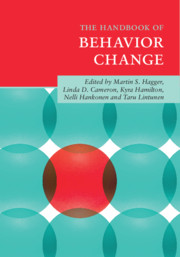Book contents
- The Handbook of Behavior Change
- The Handbook of Behavior Change
- Copyright page
- Dedication
- Contents
- Figures
- Tables
- Sidebars
- Contributors
- 1 Changing Behavior: A Theory- and Evidence-Based Approach
- Part I Theory and Behavior Change
- Part II Methods and Processes of Behavior Change: Intervention Development, Application, and Translation
- Part III Behavior Change Interventions: Practical Guides to Behavior Change
- 31 Attitudes and Persuasive Communication Interventions
- 32 Self-Efficacy Interventions
- 33 Imagery, Visualization, and Mental Simulation Interventions
- 34 Affect-Based Interventions
- 35 Autonomy-Supportive Interventions
- 36 Incentive-Based Interventions
- 37 Monitoring Interventions
- 38 Goal Setting Interventions
- 39 Planning and Implementation Intention Interventions
- 40 Self-Control Interventions
- 41 Habit Interventions
- 42 Economic and Behavioral Economic Approaches to Behavior Change
- 43 Dyadic Behavior Change Interventions
- 44 Social Identity Interventions
- 45 Motivational Interviewing Interventions
- 46 The Science of Behavior Change: The Road Ahead
- Index
- References
41 - Habit Interventions
from Part III - Behavior Change Interventions: Practical Guides to Behavior Change
Published online by Cambridge University Press: 04 July 2020
- The Handbook of Behavior Change
- The Handbook of Behavior Change
- Copyright page
- Dedication
- Contents
- Figures
- Tables
- Sidebars
- Contributors
- 1 Changing Behavior: A Theory- and Evidence-Based Approach
- Part I Theory and Behavior Change
- Part II Methods and Processes of Behavior Change: Intervention Development, Application, and Translation
- Part III Behavior Change Interventions: Practical Guides to Behavior Change
- 31 Attitudes and Persuasive Communication Interventions
- 32 Self-Efficacy Interventions
- 33 Imagery, Visualization, and Mental Simulation Interventions
- 34 Affect-Based Interventions
- 35 Autonomy-Supportive Interventions
- 36 Incentive-Based Interventions
- 37 Monitoring Interventions
- 38 Goal Setting Interventions
- 39 Planning and Implementation Intention Interventions
- 40 Self-Control Interventions
- 41 Habit Interventions
- 42 Economic and Behavioral Economic Approaches to Behavior Change
- 43 Dyadic Behavior Change Interventions
- 44 Social Identity Interventions
- 45 Motivational Interviewing Interventions
- 46 The Science of Behavior Change: The Road Ahead
- Index
- References
Summary
Habitual behaviors are initiated automatically in response to situations in which they have been repeatedly performed in the past. Making a desired behavior habitual is thought to shield it against lapses due to low motivation, while disrupting habitual performance of undesired behaviors may aid cessation. This chapter outlines how developing new cue-behavior associations so that a habit can form may disrupt unwanted habitual actions. The strategies are suggested: avoiding cues, inhibiting responses to cues, or learning new habit associations to displace old ones. Forming a new habit requires sustained motivation and ability to initiate and maintain change as new associations form. Among those willing to change, behavior change techniques that promote action control (e.g., action planning, goal setting, using prompts and cues) may particularly facilitate habit formation. Purposeful habit disruption, requires motivation but is also facilitated by identifying triggers and either avoiding them or planning alternative responses. Habit change can be facilitated or obstructed by characteristics of the target behavior, situation, or actor. For example, behaviors that are easier to perform and driven by intrinsic motives rather than external pressure are likely to rapidly become habitual. Evaluations of habit interventions suggest that they are typically acceptable to recipients and show potential in achieving meaningful behavior change.
Keywords
- Type
- Chapter
- Information
- The Handbook of Behavior Change , pp. 599 - 616Publisher: Cambridge University PressPrint publication year: 2020



